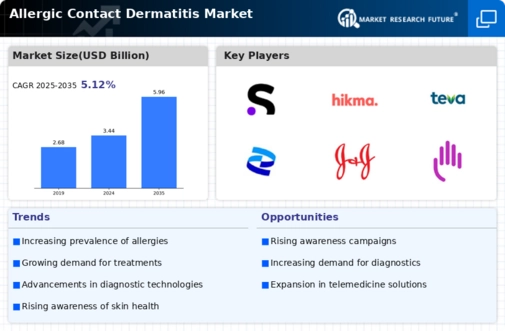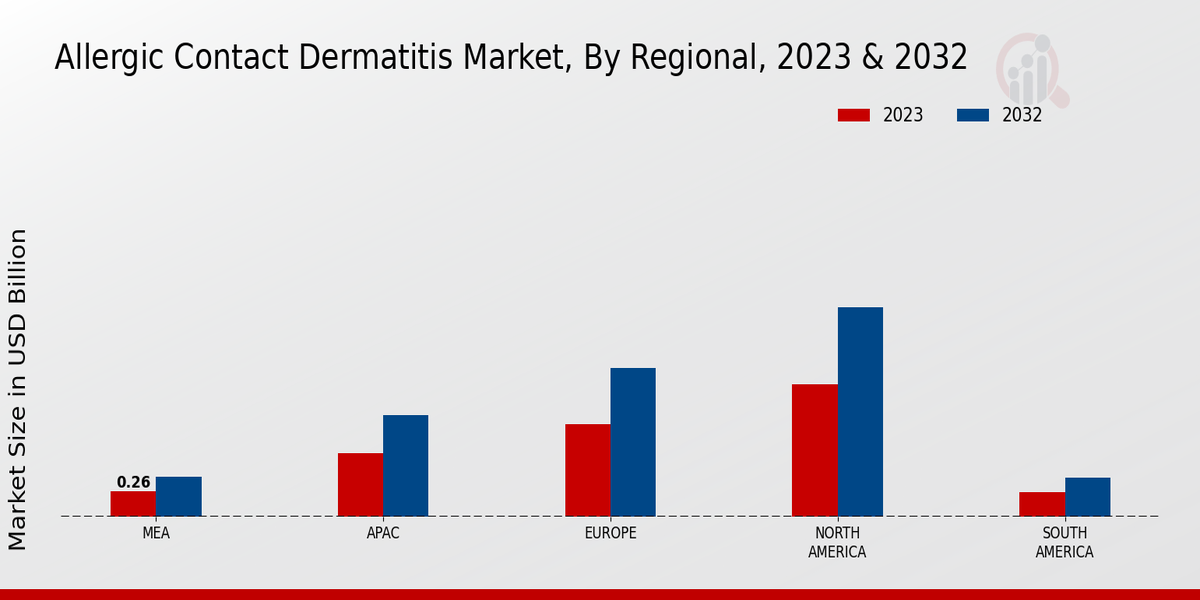Market Growth Projections
The Global Allergic Contact Dermatitis Market Industry is projected to experience substantial growth in the coming years. With an estimated market value of 3.44 USD Billion in 2024, the industry is expected to reach 5.96 USD Billion by 2035. This growth trajectory indicates a compound annual growth rate of 5.12% from 2025 to 2035. Such projections reflect the increasing prevalence of allergic contact dermatitis, advancements in treatment options, and rising awareness among the population. These factors collectively contribute to a robust market outlook, highlighting the potential for innovation and investment in the sector.
Rising Awareness and Education
Increased awareness and education regarding allergic contact dermatitis play a crucial role in shaping the Global Allergic Contact Dermatitis Market Industry. Public health campaigns and educational initiatives by healthcare organizations aim to inform individuals about the causes, symptoms, and management of the condition. This heightened awareness encourages early diagnosis and treatment, which can significantly improve patient quality of life. As more individuals recognize the importance of addressing allergic contact dermatitis, the market is likely to expand. The anticipated growth in market value to 5.96 USD Billion by 2035 underscores the impact of these educational efforts.
Emerging Markets and Economic Growth
The expansion of emerging markets and overall economic growth are significant factors influencing the Global Allergic Contact Dermatitis Market Industry. Countries with developing economies are witnessing an increase in disposable income and improved access to healthcare services. This trend allows more individuals to seek treatment for allergic contact dermatitis, contributing to market growth. As these economies continue to develop, the demand for dermatological products is likely to rise, further driving the market. The combination of economic progress and increased healthcare access presents a promising outlook for the industry.
Advancements in Dermatological Treatments
Innovations in dermatological treatments significantly influence the Global Allergic Contact Dermatitis Market Industry. The development of new topical corticosteroids, immunomodulators, and biologics offers patients more effective management options. For example, the introduction of novel therapies has shown promising results in clinical trials, leading to improved patient outcomes. As these treatments become more widely available, they are likely to enhance patient adherence and satisfaction. This trend is expected to contribute to the market's growth, with a projected compound annual growth rate of 5.12% from 2025 to 2035, reflecting the increasing demand for effective therapeutic solutions.
Regulatory Support for Dermatological Products
Supportive regulatory frameworks for dermatological products are vital drivers of the Global Allergic Contact Dermatitis Market Industry. Regulatory agencies, such as the Food and Drug Administration, facilitate the approval of new treatments, ensuring that safe and effective options reach the market. This support encourages pharmaceutical companies to invest in research and development, leading to a broader range of therapeutic options for patients. As the regulatory landscape continues to evolve, it is expected to foster innovation and competition within the market, ultimately benefiting patients and healthcare providers alike.
Increasing Prevalence of Allergic Contact Dermatitis
The rising incidence of allergic contact dermatitis is a primary driver of the Global Allergic Contact Dermatitis Market Industry. Factors such as urbanization, environmental pollution, and changes in lifestyle contribute to this increase. For instance, the World Health Organization indicates that allergic diseases are on the rise globally, with contact dermatitis affecting millions. This growing prevalence is expected to propel the market, with projections estimating the market value to reach 3.44 USD Billion in 2024. As awareness about the condition increases, more individuals seek treatment options, further driving market growth.























Leave a Comment